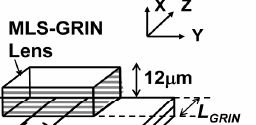Solved
GRIN FIBER LENS
Hello,
If I want to simulate a GRIN fiber lens do I have to do in non-sequential mode? I want to use the GRIN fiber as lens so I just simulated the "core" of the fiber in sequential mode.
My GRIN fiber has a parabolic refractive index profile. The core is SILICA doped with GERMANIUM so it has specified refractive index profile. How can I simulate my refractive index profile (instead using the gradient 1, 2, 3...)?
Many thanks.
Yours,
Taynara Oliveira
If I want to simulate a GRIN fiber lens do I have to do in non-sequential mode? I want to use the GRIN fiber as lens so I just simulated the "core" of the fiber in sequential mode.
My GRIN fiber has a parabolic refractive index profile. The core is SILICA doped with GERMANIUM so it has specified refractive index profile. How can I simulate my refractive index profile (instead using the gradient 1, 2, 3...)?
Many thanks.
Yours,
Taynara Oliveira
Best answer by Nicholas Herringer
Hi Taynara,
If you'd like to model propagation within the fiber, your best best is to use Non-Sequential Mode. This is because it will allow you to model both the core and the cladding, if needed. With this, if you're trying to model a parabolic profile, you can use the "grin1.dll" profile. I'd recommend taking a look at the sample file, "...\Zemax\Samples\Non-sequential\Fibers\grating-grin-fiber.ZMX" for an example of how to do this.
You can also model this type of profile in Sequential Mode using the Gradient 1, 2, 3, etc. surfaces, as you've identified. If you're just hoping to model coupling into a fiber, I'd recommend going this route and checking out the article, Single-mode fiber coupling in OpticStudio, for an example.
Regarding your question on other methods for simulating the GRIN profile, what sort of information do you have regarding the profile? Do you have an equation, sampled data set, etc.? Depending on the type of information you have, the approach might vary.
Have a great weekend!
Cheers,
Nick
If you'd like to model propagation within the fiber, your best best is to use Non-Sequential Mode. This is because it will allow you to model both the core and the cladding, if needed. With this, if you're trying to model a parabolic profile, you can use the "grin1.dll" profile. I'd recommend taking a look at the sample file, "...\Zemax\Samples\Non-sequential\Fibers\grating-grin-fiber.ZMX" for an example of how to do this.
You can also model this type of profile in Sequential Mode using the Gradient 1, 2, 3, etc. surfaces, as you've identified. If you're just hoping to model coupling into a fiber, I'd recommend going this route and checking out the article, Single-mode fiber coupling in OpticStudio, for an example.
Regarding your question on other methods for simulating the GRIN profile, what sort of information do you have regarding the profile? Do you have an equation, sampled data set, etc.? Depending on the type of information you have, the approach might vary.
Have a great weekend!
Cheers,
Nick
Enter your E-mail address. We'll send you an e-mail with instructions to reset your password.





